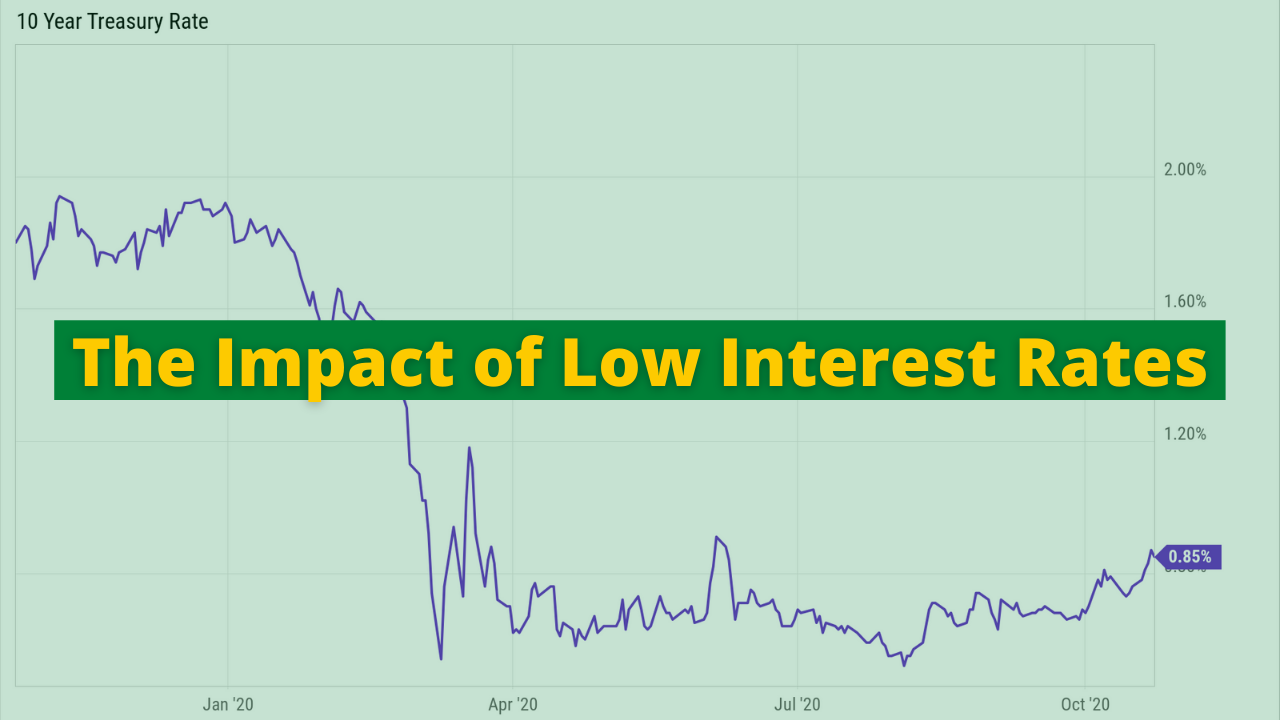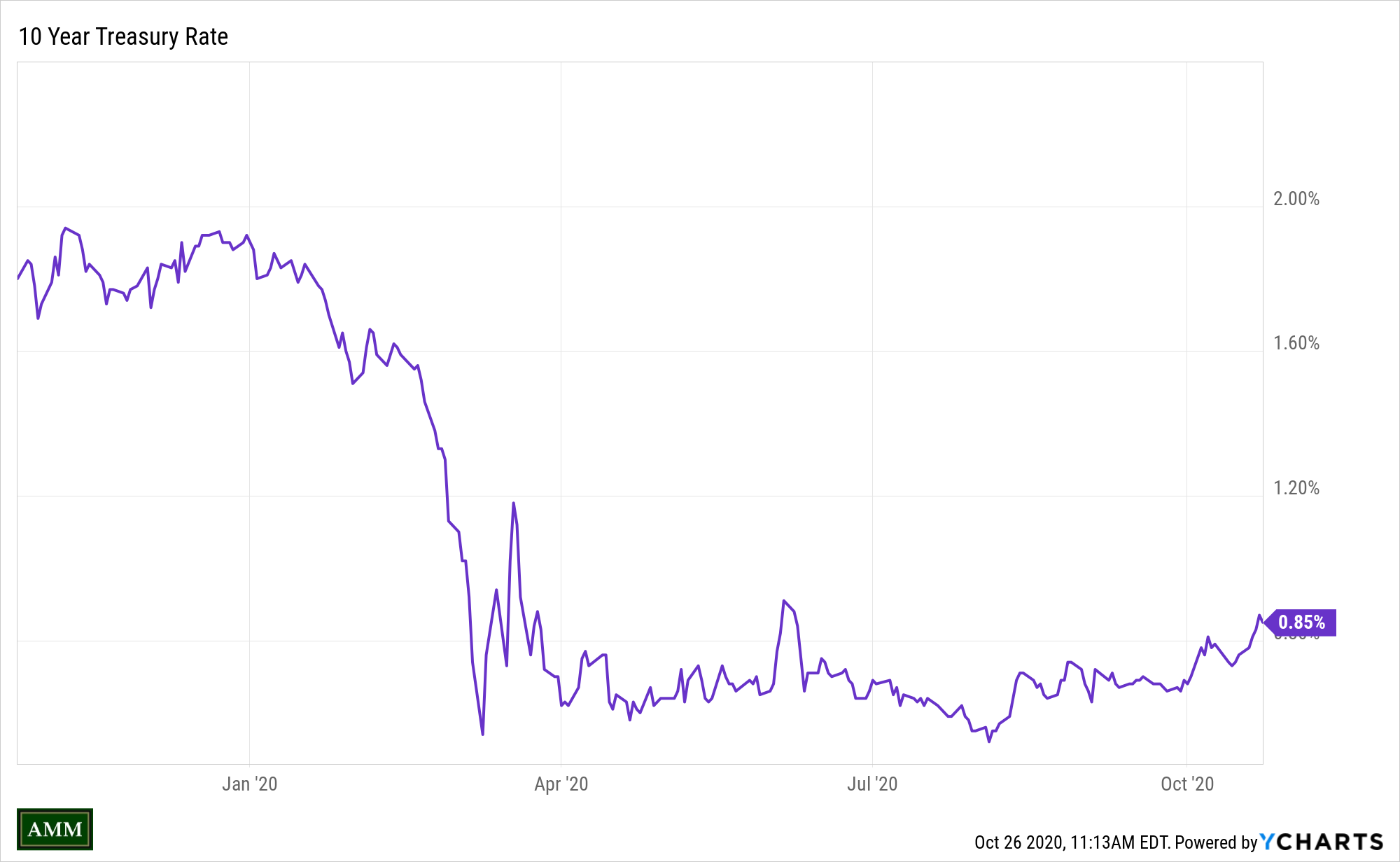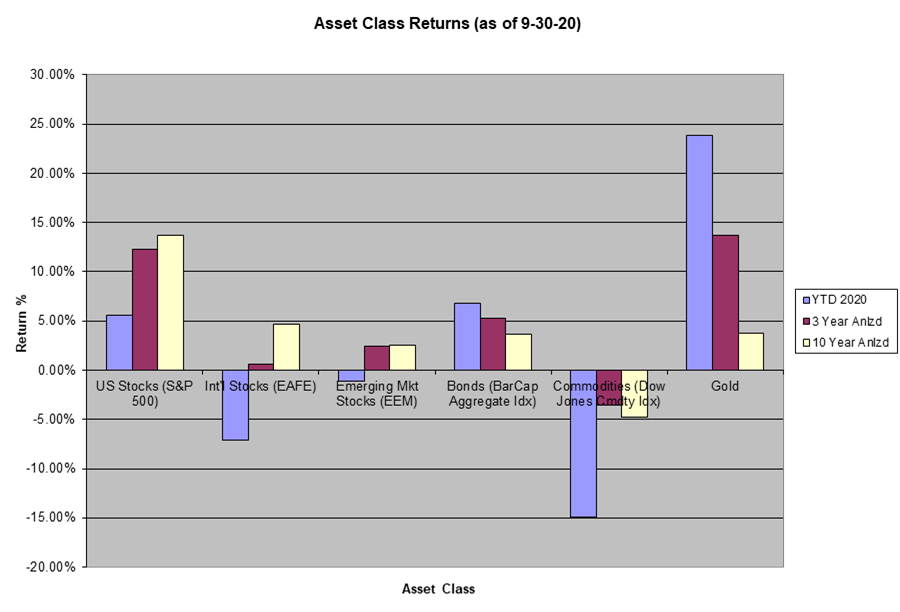Perhaps no picture better represents the financial impact of Covid than that of the 10-year Treasury yield.
While rates have remained below 3% for most of the last decade, the post Covid drop below 1% for the first time ever provides the backdrop for most of what we see occurring in financial markets today. Below are just a few of the outcomes brought to us by the low rate environment.
Stock Market
Low rates equals less competition for capital from yield-oriented assets like bonds. A simplistic comparison of the treasury yield at .83% vs. the S&P dividend yield at 1.75% highlights this point. Yes, high-quality bonds are generally much less volatile than stocks. But with yields so low there is little if any return left. In fact, with current inflation running ~ 1.7% the buyer of a ten-year treasury today is locking in a negative real rate of return. The same goes for investors in CDs, money market, or any other “risk-free” asset. Even worse, if yields unexpectedly rise bond holders will experience losses. So it should not be surprising that against this low rate backdrop, investors have gravitated towards stocks. According to data from the American Association of Individual Investors, allocation to stocks and stock mutual funds has risen 17% since March.
Bond Market
The preceding notwithstanding, most investors do not invest solely in stocks, and in the case of most institutions, they must hold some exposure to bonds via mandate. Regardless of return levels, bonds provide volatility control and a source of liquidity to investor portfolios. The Fed’s willingness to support the bond market via massive government bond purchases has created a bullish bond environment. According to a CNBC fed survey, the average forecast now has the Fed on hold from further rate increases until February 2023. The expectation of rates remaining low for many years is further supportive of bond prices.
Housing Market
Low rates on mortgages, currently at 3.04% for a 30-year mortgage are hovering near all-time lows. Cheap mortgages have swelled demand with the Mortgage Bankers of America (MBA) new purchase index up 26% year over year. In a recent interview on CNBC, CEO of real-estate brokerage Redfin Glenn Kelman, summed up the situation rather succinctly: “The level of demand is absolutely insane.”
The Market & Real Economy Disconnect
In short, low rates describe much of the perceived disconnect between “markets” and the “real economy” — where asset markets are booming but the underlying economy (jobs, GDP growth) is recovering more slowly. Essentially by setting rates low, both via the policy rate as well as the Federal Reserve’s open market bond purchases, policymakers saved markets. However, in our view, markets are not truly disconnected from the real economy. Markets represent investor expectations about the future of the economy, not the present condition. In early March, the economic future looked dark and markets reflected this outlook with a steep drop in prices.
Right now the market seems to be saying, “the real economy will recover, perhaps sooner than later, and like all past catastrophes this too shall pass.” We don’t disagree with this outlook, but we also can’t assume this rosy outcome as preordained. While the aggressive policy response to Covid has buffeted asset prices and halted what could have been a global depression, there remain deep uncertainties as to the way forward.
Economic Uncertainties & Risks
Will governments continue with the massive policy response and take on increasing amounts of debt, at a time when government debt levels in many developed countries are near all-time highs? What happens if there is an unexpected third wave of the virus and another costly lockdown? What will be the long-term effects of zero interest rate policy (ZIRP)? As is the case with an uncertain future, we simply don’t know with any degree of certainty the answers to these questions.
While this is just a sampling of the current risks to ponder when making investment decisions, the reality is that there is nothing new about this environment. Risk, simply defined as the possibility of something bad happening, is ever-present in investing. The perceived risks may change from year to year, but there is always risk in investing (or life for that matter). In our estimation investors have a handful of choices on how to invest in a risky world.
Risk Aversion
Hold only “risk-free” assets in savings and accept low nominal returns and negative (inflation-adjusted) real returns. This is a sleep at night outcome. However, it involves the slow erosion of wealth over time via inflation.
Risk Timing
Accept risk by investing in assets that offer higher return potential but seek to move out of those assets during “riskier periods” and back in to those assets during “less risky” periods. In our view, this is generally the worst choice. Risk timing requires synthesizing nearly infinite risks and variables to determine the near-term trajectory of prices. In reality, most investors pick one event, like an election or pandemic, or some other news on which to base their timing decision. Since these are known events, they are likely already incorporated into asset prices. A nasty feedback loop of selling low and buying high could ultimately lead to a major reduction in wealth.
Risk Management
Accept risk, but manage your specific risk exposure via appropriate asset allocation. If you have a generally lower tolerance for risk and volatility, then accept less risk. But accept at least some risk to provide you with an opportunity to at least beat inflation. A focus on diversification, time horizon, the odds of capital impairment, and the price you pay (lower is generally better) are other valid areas of risk management. We view this as the best option for investors seeking to maximize risk-adjusted returns in an uncertain world.
Election Outlook 2020
Much has been written about the risks of this election. Depending on your political persuasion, you may perceive the risk of your candidate losing being “worse” for the economy. The below chart provides an interesting picture of how Republicans and Democrats rated economic conditions over the last two decades. A pretty clear trend emerges. We tend to give the economy the benefit of the doubt when our party is in office and view conditions more negatively when the other party is in power.
This isn’t exactly surprising, but it can have real implications on investment returns if you let your political leanings inform your investment decisions. Republicans who de-risked or avoided stocks during the Obama years missed strong returns. Likewise for Democrats during the Trump years. An important concept to keep in mind, especially if your team loses on election night.
Finally, one thing most agree on is that a long drawn-out contested election would be bad for markets. This is probably true. However, a small silver lining here is that this potential risk has been well discussed in the financial and mainstream media, and has likely been digested in market prices to at least some degree.
Q3 Review
Year to date through 9/30/20.
- Domestic stocks (S&P 500) increased 5.7%.
- Developed international stocks (EAFE) declined -7.1%.
- Emerging market stocks (EM) declined -1.2%.
- Bonds (Bar Cap Agg Idx) increased 6.8%.
- Commodities declined -14.9%.
- Gold increased 23.9%.
We have updated our asset class return chart below.
FAANGM
Much attention in the investment community has been given to the narrow leadership in the S&P 500. In fact, 6 stocks (Facebook, Amazon, Apple, Netflix, Alphabet, and Microsoft), referred to collectively as the FAANGM stocks account for nearly all of the return in the S&P 500 so far this year. At the sector level, two stocks (Apple and Microsoft) have grown so large that they account for 45% of the entire S&P Information Technology sector, while 3 stocks (Alphabet, Facebook, and Netflix) account for 67% of the communications services sector. These numbers reflect the fact that investors view these companies’ business models as nearly unassailable. While the tech sector in general appears richly priced, we still find some holdings here attractive. Specifically, companies with a strong inclination to both pay and grow the dividends they pay to our investors.
On the other end of the 2020 performance derby are the banking and energy sectors, down approximately -25% and -46% respectively as of mid-October. The energy sector as a whole now accounts for less than 3% of the entire S&P 500 market capitalization, down from over 15% in 2008. A majority of investors seem to have abandoned energy and view this asset class as practically un-investable at this point. While not quite un-investable, banks are battling for profitability in a low interest rate environment. Data from the St. Louis Fed shows that net-interest margins (a widely followed measure of bank profitability) are at the lowest levels since they began tracking the data. As value-conscious investors, we find both of these sectors intriguing and have taken a small position in the energy sector within asset allocation portfolios.
Should you have any questions regarding your investment account(s) and personal financial plans, or if there have been any recent changes to your investment and/or retirement objectives, please do not hesitate to contact our office to speak with one of us at your convenience.
As always, we thank you for entrusting AMM to help you achieve your investment and retirement objectives.
Your Portfolio Management Team
*Individual accounts will vary based on a client’s stated objectives, risk tolerance and time frame. We manage several different portfolio strategies so not every client has exposure to the securities, asset classes or investment strategies discussed above. In addition to growth and/or income oriented asset allocation strategies, we also manage more concentrated equity portfolios that generally carry a higher degree of risk and volatility.






